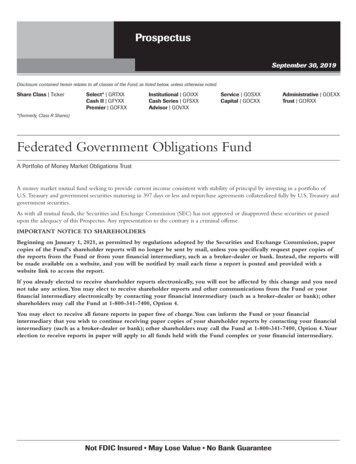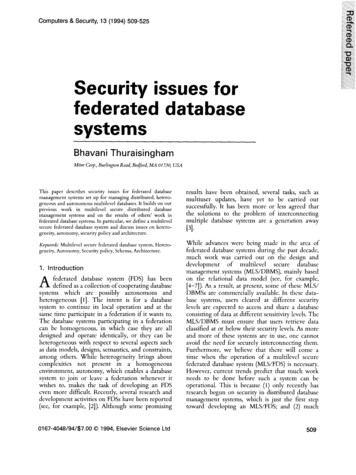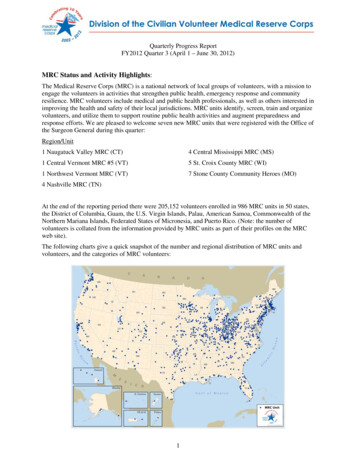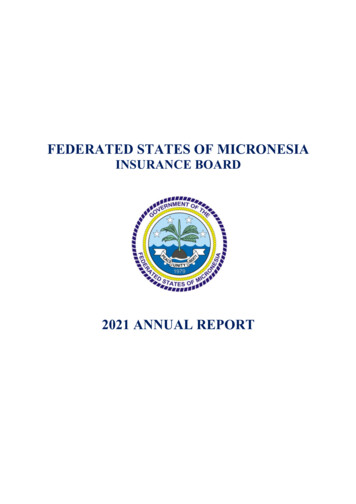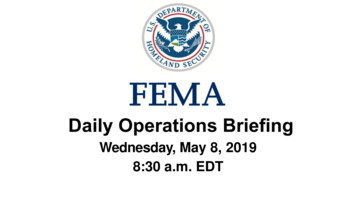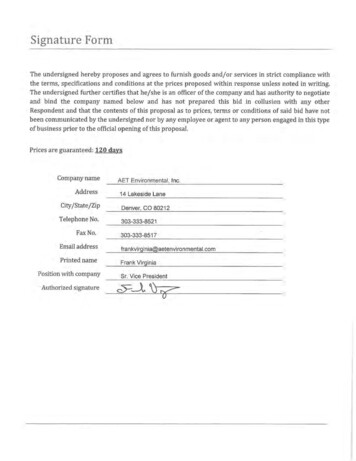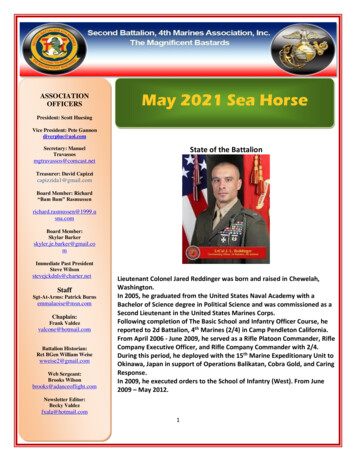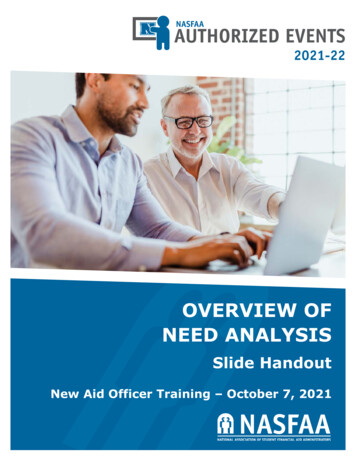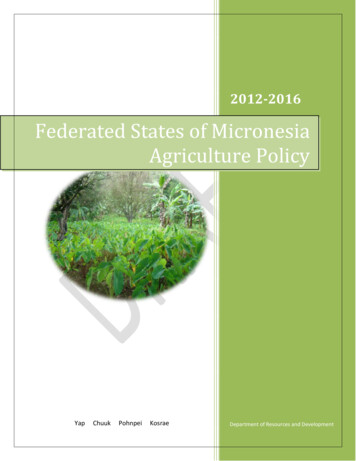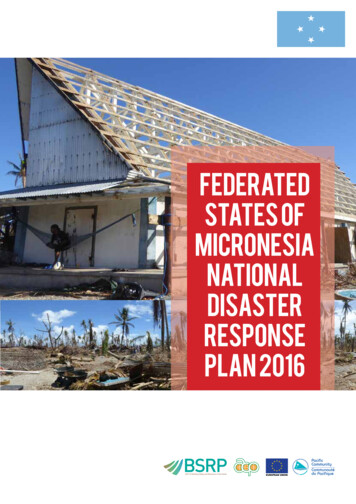
Transcription
FederatedStates ofMicronesiaNationalDisasterResponsePlan 2016
FSM Government – National Disaster Response PlanFSM Government – National Disaster Response PlancontentsOffice of Environment and Emergency ManagementFSM National GovernmentPalikir, PohnpeiDate of Issue: April 2017AcknowledgmentThe development of the response plan was made possible through the BuildingSafety and Resilience in the Pacific (BSRP) project implemented by the PacificCommunity (SPC) and funded by the European Union and ACP Secretariat aspart of the EDF10.DisclaimerThis plan has been produced by SPC and the Government of Federated Statesof Micronesia, with the support of the European Union and the assistance of theACP Group of States. The contents of this plan are the sole responsibility of theGovernment of Federated States of Micronesia and can in no way be taken toreflect the views of the European Union or SPC, or to indicate a commitment toa particular policy or action.All Photos by IOM. Government of Federated States of Micronesia (FSM) and the PacificCommunity 2017All rights for commercial/for profit reproduction or translation, in any form,reserved. Permission to reproduce the document and/or translate in whole,in any form, whether for commercial/for profit or non-profit purposes, mustbe requested in writing.Office of Environment and Emergency ManagementFSM National GovernmentPalikir, PohnpeiPART 1. POLICIES, PRINCIPLES ANDPURPOSESIntroductionDevelopment and maintenance of thePlanPossible threats to Federated States ofMicronesia National policyGeneral concept for disaster riskmanagementDM model for Federated States ofMicronesiaPrinciplesPurposes of the PlanScopeStandard Operating Procedures (SOP’S)Hazard specific contigency PlansAgency accountability and resourcesRelationship with other legislation andplansInternational relationshipsDefinitionsPART 2. INSTITUTIONALARRANGEMENTS FOR DMOutline institutional frameworkNational ArrangementsPresident and President’s Designee forDMNational disaster committee (NDC)Division of emergency management(DIV EM) - OEEMSectorsRole of womenPartner’s, Red Cross, NGO’s and civilsocietyExternal support arrangements – FSM/US compact and UNPrivate sector and critical infrastructureAgenciesState arrangementsGovernor and head of state office fordisaster managementState disaster committee’s (SDC’S)0102030405060708091113161819State DM officeMunicipal, village and outlying islandArrangementsA)Municipal DM committeesB)Village DM committeesSOP’S for municipal and village DMcommittees2122PART 3. OPERATIONALARRANGEMENTS FOR DMFunctions of disaster managementoperationsA) Preparedness functionsB) Response functionsNational level operationsNational disaster committee (NDC)Role of disaster coordinator who is theAssistant Director EMRole of NEOC Operations ManagerDeclaration of a disasterActivation of operations arrangementsActivation for non-declared eventsNational disaster coordination team(NDCT)National emergency operations centre(NEOC)NDCT coordination working groupsState level operationsState disaster committeeState disaster coordination TEAMS(SDCT’S)Role of state disasterCoordinating officer (DCO)State emergency operations centres(SEOC’S)SDCT Coordination working groupsLocal level operationsMunicipal, village and outlying islandarrangementsApproval2420Date of Issue: April 2017Disaster Management (DM) Preparedness Response Transition to RecoveryDisaster Management (DM) Preparedness Response Transition to Recovery325262728293233
FSM Government – National Disaster Response PlanAbbreviations and Acronyms:Act:FSM Disaster Relief Assistance Act of 1989 (or subsequent Act)A/Sec:Assistant SecretaryAsst Dir EMAssistant Director for Div of Emergency Management within OEEMCCAClimate Change AdaptationCWGCoordination Working GroupDCDisaster Coordinator at national operations levelDCODisaster Coordinating Officer at state operations levelDMDisaster Management preparedness, response and transition to recoveryDRMDisaster Risk Management DM DRRDRRDisaster Risk ReductionFSMFederated States of MicronesiaIDAInitial Damage AssessmentIOMInternational Organisation for MigrationMRCSMicronesia Red Cross SocietyNDCNational Disaster CommitteeNDCTNational Disaster Coordination TeamNEOCNational Emergency Operations CentreNGONon-Government OrganisationPDNAPost Disaster Needs Assessment – for transition to recoveryPHTPacific Humanitarian Team managed by UN regional office of UNOCHASDCState Disaster CommitteeSDCTState Disaster Coordination TeamSEOCState Emergency Operations CentreSOPStandard Operating ProceduresState DCOState Disaster Coordinating OfficerState DMOState Disaster Management OfficeTORTerms of ReferenceUSAIDUS Agency for International DevelopmentFSM Departments:DoEDept of EducationDoJDept of JusticeDF&ADept of Finance and AdministrationDoFADept of Foreign AffairsDHSADept of Health and Social AffairsDRDDept of Resources and DevelopmentDTC&IDept of Transportation, Communications and InfrastructureOEEMOffice of Environment and Emergency ManagementFSM Government – National Disaster Response PlanPART 1. Policies, Principlesand PurposesIntroduction1. This plan provides for the establishment of national institutional arrangements for theFederated States of Micronesia (FSM) government for responding to emergency and disasterevents within the country.It includes arrangements for preparedness, monitoring for potential events and responseat the national level to manage national level events and support state level events. It alsooutlines arrangements to guide state disaster response plans and their connection to thenational level arrangements. It includes provisions for accessing international support.Development and Maintenance of the Plan2. This Plan has been prepared under the Disaster Relief Assistance Act 1989 (the Act)Section 707 subsection (3) and outlines arrangements as minimum requirements for statedisaster response plans under Section 707 subsection (2) – refer also to Section 706subsection (1). This Plan has been approved by and promulgated by the President.This Plan establishes the National Disaster Committee (NDC) and may be adjusted by theCommittee and re-issued as an amendment, effective from the date of re-issue. Substantiveadjustments are to be approved by the President.Notwithstanding any amendments, this Plan is to be reviewed by the National DisasterCommittee at intervals not exceeding five years and submitted to the President for approval.4Disaster Management (DM) Preparedness Response Transition to RecoveryDisaster Management (DM) Preparedness Response Transition to Recovery01
FSM Government – National Disaster Response PlanPossible Threats to Federated States of MicronesiaThe possible threats to the Federated States of Micronesia are significant. They include:lllllllllllllTropical storms and typhoonsTidal and wave andemicsAgriculture pests and diseasesAviation and maritime disastersFiresIndustrial accidentsMarine pollutionFSM Government – National Disaster Response PlanThis policyrecognizes boththe strengths andthe difficultiesof implementingdisastermanagementacross the widelydispersed andlargely ruralcommunities of theFederated States ofMicronesia.National Policy5. The Government of FSM recognises its role to provide for themanagement of disasters and disaster risk. This Plan seeks tostrengthen national and state governance arrangements andconnections into communities through local government and localsocial institutions.The Government of FSM adopted a policy for nationwide integrateddisaster risk management and climate change in December 2013.The relevant parts of this provide for:ll6. This policy is based upon the understanding that:lllllllllllLoss of lifeInjuryDamage to and destruction of propertyDamage to subsistence and cash cropsLoss of livelihoodDisruption of lifestyleDisruption of servicesDamage to infrastructure and disruption of government systemsNational economic lossSociological and psychological after-effects02Disaster Management (DM) Preparedness Response Transition to Recoverydisasters, when they occur, can be overwhelming for smallisland developing states and negate years of developmentactivitysound and widely understood arrangements for managingdisasters can substantially reduce the trauma of disasters incommunities and the time taken to recover7. This policy recognises both the strengths and the difficulties ofimplementing disaster management across the widely dispersedand largely rural communities of the Federated States ofMicronesia.For disaster response this Plan is based upon:l4. In general terms, the effects of disasters on the country and its people include:lstrong horizontal and vertical coordination betweensectors, national, state and community levels using an ‘allof-government’, ‘all-of-country’ coordinated approach thatemphasises partnerships between the public sector, privatesector and civil society, andspecial attention to gender issues and the needs ofmarginalised groups, such as small atoll communities, personswith disability and the elderlyllleveryone (individuals, communities, agencies, sectors andlevels of government) having a role within their community orsector to prepare for and manage the impacts of disasters;supporting community self-sufficiency and reinforcing localmechanisms in preparing for, managing and recovering fromdisasters;setting clear arrangements with accountability measures sothat everyone can carry out their role; andproviding for access to support and resources throughnational, regional and international arrangements based onthe assessed scope and scale of an emergency or disasterevent.Disaster Management (DM) Preparedness Response Transition to Recovery03
FSM Government – National Disaster Response Plan8. This policy recognises the fundamental role of government to establish and sustain arrangements fordisaster management across sectors and communities in FSM. In this Plan these arrangements include:lllllmonitoring and assessment of hazards;setting policies, institutional arrangements and accountability mechanisms to oversee and implementdisaster preparedness and response and for transition to recovery;establishment of communication and early warning systems in communities;integrating disaster preparedness and response in national, sector and state development plans andbudgets; andengagement with international partners and support agencies to ensure communities receive supportduring times of significant disaster.9. This policy provides that agencies across all sectors that have a role under this Plan are required to developcapacity and plan and provide for that role.FSM Government – National Disaster Response PlanFSM Disaster Mangement ModelDisaster Management arrangements - creating capacityfor self helplSupporting communities managing their disastersthroughpreparedness for response and recoverylSetting arrangement for coordinating response,assessing impacts and for receiving relief supportinto the community levelThis is everybody’s business - Whole of country,government, sectors, NGO’s communities and individualsGeneral Concept for Disaster Risk ManagementnatiomrInfo10. The general concept of disaster risk management is that communities address the hazards they face andare supported to take measures to prepare for, respond to and recover from disasters when they occur. Atthe same time, and over time, communities are supported to take measures to reduce their vulnerability todisaster and climate risk.Both these sets of measures require coordinated arrangements across sectors and levels of government toaccess the necessary information for decision-making and the necessary support for taking action.11. The general concept provides for actions through existing structures and mechanisms coordinated throughspecial arrangements for disaster management. These special arrangements are required to set the roles andaccountabilities for each agency involved and their connections with other agencies and with communities.12. This Plan sets out the special arrangements for preparedness and response at the national level forsupporting state disasters and for managing national level events in FSM. It also outlines arrangements forstate disaster response plans and the connections to national level and international assistance.aliontarnlInte gionaRealionNat&or t eppSu dencfiC onteStapalnici euM lagV ilpoSuprt14. The above model follows the general concept of DRM outlined above and is adopted to guide the disastermanagement arrangements set out in this Plan:13. During disasters arrangements need to provide for the assessment of impacts to influence decisionmaking at all levels and provide a basis for accessing and deploying available resources.Disasters are overwhelming and a clear focus on levels of decision-making is necessary to avoid delayed ordysfunctional responses. This Plan provides for the clear separation of functions and decision-making at theexecutive, oversight and operations levels.Under this Plan, agencies (including the private sector and civil society) will understand their roles, the explicitarrangements for fulfilling them, and the accountability measures in place.Under this Plan, agencies (including the private sector and civil society) will understand their roles, the explicitarrangements for filling them and be accountable for working within them.DM Model for Federated States of Micronesia04Disaster Management (DM) Preparedness Response Transition to RecoveryDisaster Management (DM) Preparedness Response Transition to Recovery09
FSM Government – National Disaster Response PlanPrinciplesFSM Government – National Disaster Response Planll15. The following principles have been adopted to guide the processes of this Plan:la)b)c)d)e)f)g)h)i)j)k)l)m)It is a role of the FSM government to provide for disaster preparedness and response through nationaland sector planning and to support state, municipal and local arrangements.Supporting self-reliance at all levels – and avoiding creating dependence – is the fundamental principleof this Plan.Providing for a balance in addressing disaster impacts on livelihood, infrastructure and land use isessential for sustainability.This Plan is multi-hazard and knowledge of disaster and climate risks within FSM is necessary to supportthe arrangements.National and state commitment and engagement with partners through this Plan is vital for effectivedisaster response.Disaster management is everyone’s business with this Plan providing for strong horizontal and verticalcoordination between sectors and between national, state and community levels.Sustainable arrangements build on existing institutional and social structures and processes across alllevels.The involvement of women in arrangements at all levels is essential for effective disaster management.This Plan will account for the needs of vulnerable and marginalised groups including those in remoteatolls, persons with disabilities and the elderly.Partners, NGOs and regional/international organisations supporting disaster response within FSM areexpected to work within and support this Plan.This Plan recognises the autonomy of state governments and ancestral land rights within FSM.This Plan recognises community and individual rights and is based on a concern for equity and fairness.This Plan will need to be piloted to develop the confidence and knowledge of those with roles within it.Purposes of the Plan16. The purposes of this Plan are to:lllllldetail high-level institutional arrangements for the overview and implementation of disastermanagement in FSM;set explicit operational structures for disaster response management at the national level for supportingstate emergencies and disasters and for managing national-level events;outline operational structures for disaster response management at the state level for supportingarrangements at the municipal, village and outlying islands levels;allocate roles and accountabilities for disaster response management to agencies across sectors andlevels of government including civil society and the private sector;promote arrangements in disaster response management that are gender and child specific, whichaddress the needs of marginalised and vulnerable groups and provide for the involvement of women;set arrangements for disaster response management that recognise the changing scope of the FSM/USA Compact and the wider Pacific regional associations.Scope17. The scope of this Plan in relation to the above purposes is to address arrangements for dealing withemergencies (non-declared events requiring cross-sector coordination) and disasters (declared events)including:llmonitoring hazard alerts and potential situations leading to emergencies and disasters throughout FSM;assessment and decision-making leading to the activation and management of arrangements forresponding to emergencies and disasters;06lldeclaring a state of disaster;commitment to, and management and coordination of activities and resources to respond to anemergency or disaster event;accessing and interfacing with external support when needed;special executive powers available during a state of disaster; andtransition to recovery following a disaster event.Standard Operating Procedures (SOP’s)18. Standard Operating Procedures (SOPs) must be prepared for any committee, team, working group orcenter having a role under this Plan. SOPs are to set out the membership, terms of reference and mode ofactivation and operation of the committee, team, working group or centre and are to be approved by the NDCor the relevant State Disaster Committee (SDC) as provided for in this Plan.SOPs shall include accountability provisions to minimise the potential for losses and misappropriation ofresources and funds during disaster operations.Once approved, SOPs become part of this Plan, and will include obligations and accountability mechanisms.Hazard Specific Contingency PlansHazard-specific contingency plans prepared to supplement the general provisions of this Plan are to beapproved by the NDC. Once approved, they become part of this Plan, and will include obligations andaccountability mechanisms.Agency Accountability and ResourcingAny agency (including from civil society and the private sector) with a role under this Plan must ensure it isable to fulfil that role and must plan and develop capacity for it.21. Agencies are responsible for resourcing their commitments. During and following a disaster, governmentagencies may submit requests through the NDC to government for supplementary funding as appropriate torecover response costs.Relationship with Other Legislation and Plans22. This Plan and the Act set out roles, powers and coordination mechanisms for agencies with roles indisaster response. During and following a declared disaster, this Plan and the Act take precedence over otherplans and legislation where necessary, in relation to powers, priorities and coordination for the disaster. Duringand following an emergency (or non-declared event), the relevant legislation and regulations prevail.State Disaster Response Plans should be consistent with this Plan to provide for horizontal and verticalcoordination between sectors and at the national, state and community levels.During nationally-declared events, state disaster response arrangements may be subject to direction fromnational governments as provided for in this Plan.Nothing in this Plan supersedes agencies’ obligations under their respective government legislation.Any agency plans, or hazard-specific contingency plans for addressing disaster response are to be consistentwith this PlanUS Compact of Free Association exists with the Federated States of Micronesia and the United States. It provides U.S.economic assistance including eligibility for certain U.S. federal programs), defence of the FSM, and other benefitsin exchange for U.S. defence and certain other operating rights in the FSM, denial of access to FSM territory by othernations, and other agreements. The agreement began in 1969.1Disaster Management (DM) Preparedness Response Transition to RecoveryDisaster Management (DM) Preparedness Response Transition to Recovery07
FSM Government – National Disaster Response PlanFSM Government – National Disaster Response Plan23. For health, environmental and agriculture disasters, this Plan will support the lead agents of thosedisasters with guidance, roles and coordination mechanisms. For aircraft or shipping incidents or search andrescue incidents at sea, this Plan may act in support of the lead agents for those incidents.Contingency Planning: the process of describing roles/responsibilities and arrangements for the performanceof key response functions specific to a designated major threat (e.g. tsunamis, droughts, major fires, hazardousmaterials incidents, airport/port emergencies, animal/plant disease, marine pollution etc.International RelationshipsCoordination: the bringing together of organisations to ensure effective emergency and disastermanagement response; is primarily concerned with systematic acquisition and application of resources(people, material, equipment and systems) in accordance with requirements imposed by the threat or impactof an emergency or disaster.24. The arrangements set out in this Plan acknowledge and provide for the delivery of relief and recoveryassistance from international partners and relief agencies during and following a disaster. These agenciesand the lead personnel involved at the appropriate working level should make themselves familiar with thesearrangements.To the extent practicable, these agencies are expected to establish their support mechanisms within thearrangements of this Plan and support the coordination processes of the National Disaster Coordination Team(NDCT) established under this Plan.Access to international and regional support arrangements will be exercised through the oversight function ofthe NDC. Management of the support will be exercised through the operations functions of the NDCT.Practical coordination and support should be made through the NEOC Management Unit and the appropriateCoordination Working Groups (CWGs) and their state equivalents.Definitions25. The following definitions apply to this Plan:Climate Change Adaptation: the reduction of vulnerability to the increasing risks of climate change andclimate variability through adaptation processes and strengthening human and institutional capacities toassess, plan and respond to the challenges.08Disaster Management (DM) Preparedness Response Transition to RecoveryCritical Infrastructure Agencies: agencies that own, manage or operate infrastructure, which is critical forlivelihood following a disaster, and includes transport, water, wastewater, electricity, gas and communicationsand broadcasting.Disaster: a declared event under this Plan at the national or state level. It is a serious disruption of thefunctioning of communities or society causing widespread human, material, economic or environmental lossesthat exceed the ability of the affected communities or society to cope using normal arrangements and whichrequire special coordination of resources under the arrangements of this Plan.Disaster Management: setting arrangements and accountabilities across levels of government, sectorsand communities for accessing and coordinating resources for managing disasters when they occur throughpreparedness, response and transition to recovery.Disaster Risk Management: supporting communities to understand and manage hazards and disastersfor safeguarding lives, property and livelihood through the performance of all forms of activities for disastermanagement and disaster risk reduction to lessen the impacts of natural, man-made, environmental andtechnological disasters.Disaster Risk Reduction: taking action to reduce the risks of hazards and the potential impacts of disasterswithin the broad context of sustainable development.Disaster Management (DM) Preparedness Response Transition to Recovery09
FSM Government – National Disaster Response PlanFSM Government – National Disaster Response PlanEmergency: a non-declared event under this Plan of such severity and magnitude to warrant national supportand cross-sector coordination as provided for in this Plan but without the powers of this Plan.Hazard: a potential or existing condition that may cause harm to people, or damage to property or theenvironment.Lead Agency: an agency accountable for the management of a specified type of disaster event.National Emergency Operations Centre: a facility from which the national level operational managementand coordination of an emergency or disaster is carried out and through which external support to a disasterwithin FSM will be managed.Preparedness: : the arrangements and systems (including alert and warning systems) to ensure that, shouldan emergency occur, communities are prepared and all those resources and systems that are needed to copewith the effects can be efficiently mobilised and deployed.Recovery: the coordinated process of supporting disaster-affected communities in reconstruction of thephysical infrastructure and restoration of emotional, social, economic and physical well-being.Response: the actions taken in anticipation of, during, and immediately after an emergency or disaster toensure that its effects are minimised, and that people affected are supported to become self-reliant to theextent necessary for their safety, wellbeing and livelihood.PART 2. InstitutionalArrangements for DMRisk: the likelihood of harmful consequences arising from the interaction of hazards and vulnerable elements(people, infrastructure or the environment).Outline Institutional FrameworkSectors and Sector Agencies: areas of government or economic activity, and the agencies within them with acommon focus or shared characteristics, which are expected to address disaster risk management issues in acoordinated as well as individual manner – e.g. the health sector or tourist sector.26. The outline of the institutional framework for the management of disasters in FSM is shown in Fig. 1.Relief: a component of response being the coordinated process of providing humanitarian relief and basiccommunity support services during and immediately after the impact of a disaster.Standard Operating Procedures: the prescribed routine action to be followed by staff during emergencyoperations.State Emergency Operations Centre: a facility at a state level from which the operational management andcoordination of a state emergency or disaster is carried out and through which national level support will bemanaged.Vulnerability: the extent to which the structure, services or environment of a community or sector are likely tobe damaged or disrupted by the impact of a hazard event.At the executive level, the President is responsible under the Act for coordinating national activities andassisting states. The President designates a government agency to be responsible for disaster management.The appointed secretary or director of that agency is the President’s designee under the Act. Currently this isthe Director of the Office for Environment and Emergency Management (OEEM).At the oversight level for collective accountability and oversight of disaster management in FSM, thisPlan establishes the National Disaster Committee (NDC), to be chaired by the Director of the OEEM, andcomprising appointed secretaries of departments and heads of government agencies.This Plan establishes functions for the NDC, addressing the government policy positions and arrangementsfor disaster management that comprise preparedness, response and transition to recovery. The NDC is alsothe strategic decision-making body for committing resources and priorities and advising the President duringa disaster.At the operational level, Part 3 of this Plan establishes national operational arrangements for disaster responsecoordination comprising the National Disaster Coordination Team (NDCT), Coordination Working Groupsof national sector agencies, and other operational partners. During emergencies and disasters, the NDCToperates through and is supported by the National Emergency Operations Centre (NEOC). The NEOC ismanaged by the Emergency Management Division (EM Div) of OEEM, which is responsible for preparednessand operational response arrangements at the national level, and for supporting state level arrangements.10Disaster Management (DM) Preparedness Response Transition to RecoveryDisaster Management (DM) Preparedness Response Transition to Recovery11
FSM Government – National Disaster Response PlanFSM Government – National Disaster Response PlanThe SDCT is chaired by the Manager of the State DMO. This manager is the State Disaster CoordinatingOfficer (State DCO).National ArrangementsPresident and President’s Designee for DM28. The President is responsible for:lllllllreceiving advice from the NDC and his/her designee;approving the policy and regulatory framework for DM in FSM on the advice of the NDC;approving this National Disaster Response Plan on the advice of the NDC;committing resources for government activity in disaster management;decision-making in relation to priorities, committing resources and accessing international assistanceduring disasters;assisting states in their disaster preparedness and response; anddeclaring a state of disaster on the advice of the NDC Chair and at the request of a state governor.29. The President’s designee for DM is responsible for:ll27. This Plan outlines arrangements for state disaster management as minimum requirements under the Act toguide the development of State Disaster Response Plans.At the state executive level the Governor is responsible for coordinating state and municipal disasterpreparedness and response activities and for sup
l Industrial accidents l Marine pollution 4. In general terms, the effects of disasters on the country and its people include: l Loss of life l Injury l Damage to and destruction of property l Damage to subsistence and cash crops l Loss of livelihood l lDisruption of lifestyle l Disruption of services l Damage to infrastructure and disruption .

